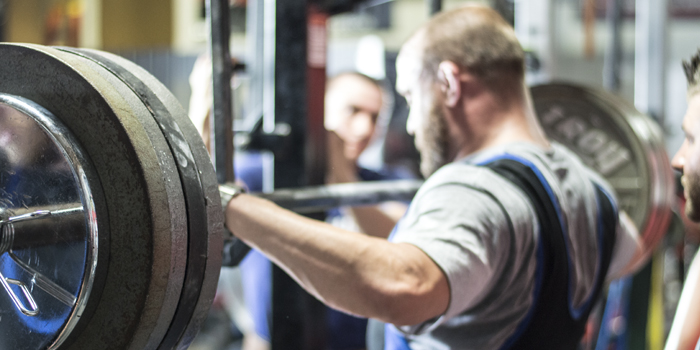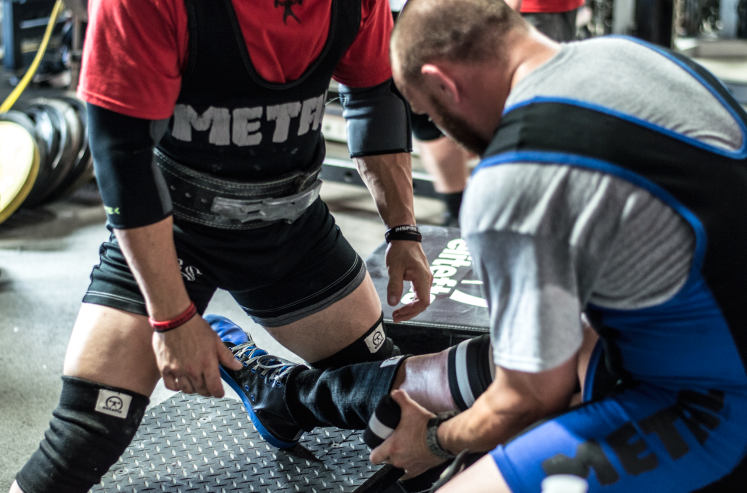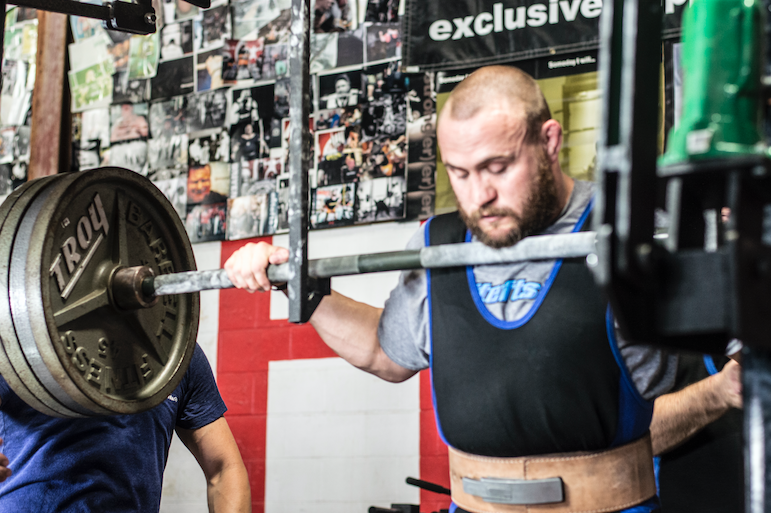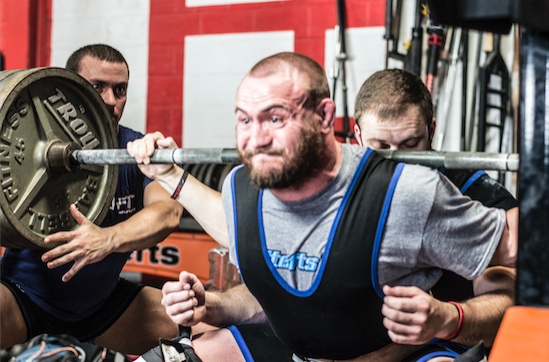
Peter heard his name and the bar was loaded for his first snatch. That’s how this series started: with Peter’s negative self-talk. He questioned why he was lifting and ended up questioning his own identity. His negative self-talk led him to redefine his relationship with weightlifting. While doing so, he redefined his identity, his goals, his motivational structure, his passions and hopes. He decided institutional competition was not for him anymore. But weightlifting would be in his heart forever; he never stopped doing it and never will.
That’s where we start this chapter: the motivational architecture for lifting is not the same as the motivational architecture for competing. They do overlap but they are different.
This whole series is marked by real life illustrations of tragic episodes in a person’s life, in the Aristotelian sense: for Aristotle, tragedy is the discovery of the hero’s (you) true identity through anagnorisis. Anagnorisis is that moment when one transitions from ignorance to knowledge. This moment is not always pleasant. However, if we are to be the masters of our own fate, it is a necessary step. It is part of truly growing up (which should never end).
Is it possible to be successful or a high performer without any of this critical thinking bullshit and just go for the gold, ignoring the dark ocean of a subconscious motivational architecture? Of course it is! I would say most high performers at any given time are uncritical (as most people are).
However painful, I still recommend critical thinking and self-awareness. Among its many beneficial side effects, it is protective against the consequences of catastrophic injury and illness, against the helpless perplexity in face of defeat, and it promotes a healthier, more productive, longer and frequently higher quality relationship with whatever it is one is engaged in. Let’s say lifting: people who know why they are lifting, why they are competing, what their goals are, and how they are passionate about it usually stay longer in the game and achieve excellent results in a stable manner.
Sport
Anything related to competition requires a discussion about the nature of sport. Sport is defined as an “institutionalized game” (and a game is an autotelic[1] competitive activity, but that’s a whole new subject). By “institutionalized” we mean it is governed by an organization that creates and enforces rules and an internal hierarchy (referees, directors, technical committee, etc). In other words, a power or political structure (Guttman 2007, p. 1-3, Dunning et al 2004, p. 47).
Deciding to lift competitively means deciding to take part in that structure as an athlete, which is the least empowered member of the organization. It means not only lifting according to the technical definition of a lift, but leaving to three referees assigned to your platform to decide whether your lift was performed according to the rules or not.
A competition is a test of performance. Any competition—whether in sports, academia, business or any other merit-based endeavor—is a test of whatever is defined by the rules as performance and which can be measured by some criteria. The objective of a competition is to win. Sometimes there are “external things” at stake, sometimes it is completely autotelic, but winning is always the objective. Ranking high is another important objective in many meritocratic endeavors. However, a rank is an ordered list that starts with the “best,” or the winner. Therefore, winning is still the objective, the rank being the result of striving to win.
The anti-competition and anti-meritocratic voices are strong and numerous. I only brought the subject up, though, because I am sure that, as you reached this point, a thought crossed your mind: “what about all those people who say that what matters in a competition is participating?” This is ideological and only serves the purpose of confusing a technical discussion. Even if you know there is not a chance in hell you will ever win that game, if you are participating, you are “giving your best,” meaning you are taking part in it with the winning mindset.
RECENT: Why Do You Lift — What the Absence of Motivation Teaches Us (Suicide)
When we draw this line separating competitive lifting from “lifting for yourself,” things get a bit clearer. Many lifters, some of which have been the best in their competitive years, are emphatic in claiming they will only stop lifting when they die, that they can’t envision a life without lifting, or that they’d rather die than stop lifting. But they won’t compete.
So some people, and some very good lifters, have a whole motivational architecture that excludes competition and totally excludes the sport: they want nothing to do with the organizational structure.
Money and Professionalism: Getting the Elephant Out of the Room
In traditionally professional sports, money is not a taboo subject. It is dealt with in a matter-of-fact manner. Lots of players will be open as to why they signed a contract with another team: they were offered more money. Does that mean they don’t have intrinsic motivation at all to play that sport? They probably do. It is very hard to be extremely good at something you don’t even like or take some pleasure out of, and except for a few fields directly related to managing money, making money is hardly the only motivation for true excellence. Some research actually shows that for qualified occupations, offering more money may not affect productivity (Ariely et al 2009, Pink 2011).
Money is a taboo issue in sports that are not really professional but want to be so, or in those that during the Cold War were “professamateur” sports, since socialist countries’ athletes were actually supported by the state to train and compete just like professional athletes in western countries.
What about sports that now have some prize money, but no employment contract like the pro sports?
Being a true professional athlete has legal implications. There are contracts, usually athletes have their representatives in associations or unions, there is special health insurance, and other insurance related to it, benefits are a hot topic in negotiations, etc.
None of this is taken into consideration by the thousands of young athletes in amateur sports who believe that having a sponsor is a big thing, even if it means being paid with a pot of whey per month that won’t cover his own consumption needs. They equate this as being a professional athlete. For some reason, having a sponsor or getting some prize money is frequently seen as a higher measure of athletic value than winning a sanctioned official competition.
Can we say that the motivational architecture for these young athletes is constructed around financial gains, as it certainly is for properly professional athletes in professional sports? No. It sounds a bit twisted, but since objectively the money involved is negligible (see Dave Tate in How Much Money Do Powerlifters Make?), the payment (whether barter or actually a small stipend) is a “proxy” for merit recognition, and a perverse one for that matter: the company will choose their sponsored athletes based on a number of attributes and merit is not necessarily the most important. Sexual appeal may rank higher, especially for female athletes.
We can safely say that it is (even if “by proxy”) merit recognition, or even any recognition, rather than the money, that fuels the extrinsic motivators in these athletes’ motivational architecture.
If a tree falls in a forest and no one is around to hear it, does it make a sound?
There are infinite variations of this idealist question pertaining to the nature of reality, one of which is: if a below parallel squat is performed by a male lifter that weighs 1811 pounds/82.5 kilograms, with sleeves only, at an empty gym, with no cameras, with a bar loaded with 772 pounds/350 kilograms, is it still the heaviest squat performed in that weight class? Did anyone even squat in that empty gym?
“To be is to be perceived”, wrote Berkeley in the XVIIth century (Fogelin 2001). That type of idealism is hardly espoused by anyone today. What we do have is a much more down to earth sociological perspective according to which social validation is basic to fact construction. Therefore, the squat obviously happened, whatever sophisticated version of realism we adopt. It is not, however, a fact in the sport.
What if there was a witness? That is still not enough to create a fact. It may and probably will create an urban legend. How many times have we heard things like “I knew a guy who could bench that (let’s say, 300 kilograms) for 10 reps.” That’s not a fact or a lie; it’s a legend. Not that different from ghost stories told by the campfire.
One of the reasons people will pay an entry fee, travel a more or less long distance, stay in line for the weigh-ins, and lift in front of three certified judges is to validate their deed. Whatever they lifted there and was considered a good lift becomes a fact in the sport.
The validation of a deed may be a more relevant item in the motivational architecture of the competitor than the will to win. Here we are not talking about the “competition against yourself” perspective, but creating a fact that is relevant to one’s identity. No matter what, that individual is a lifter and belongs to the lifting community.
The tree fell and everyone heard the noise, in the form of a spreadsheet published at an official sanctioning body website.
Transcendence Versus Relatedness
Several studies show people perform better if they have an audience, although the opposite can also happen (Schmidt et al 1986, Jones et al 2007). High-performance athletes obviously belong to the class that responds to audience presence with increased performance.
The common sense explanation to this improved performance provided by an audience is the need for social approval. One will put in all his strength and even push further into the mysterious protected realm of absolute strength if the desired social approval is within reach, reinforced by hysterical screams from the audience.
Who hasn’t seen this happen?
We do, however, have different types of athletic overachievers in the sports that require focus (as opposed to those that require a heightened state of environmental awareness). Let’s take powerlifting, because we are here, at elitefts.com. We have the super psyched up lifter who will even address the audience, interact with it at the platform, ready to lift, invite the audience to participate, scream, and make eye contact with people. We also have the opposite: the lifter who goes through a precise sensory funneling, eliminating sensory input that is not absolutely essential for the execution of the actions related to performance. These actions are automatized to such a high degree that these individuals are capable of entering an altered state of consciousness where they cease to be aware of time, space (to a degree) and even the self (Tenenbaum 1999).
We have also all seen this before. Some of these individuals don’t even make the traditional eye contact with the judge when they are ready to receive the “squat” command. Their gaze is unfocused.
They “come back” (from wherever they were) and celebrate effusively if they happen to be given more than one white light.
Do these people compete because of this “high”? Is the “high” a benign side effect of their primary motivator of relatedness (one of the three basic psychological needs of any human being)? There is no answer.
Reaching that special state, frequently described in narratives as resembling a mystic experience, is an important factor for some athletes.
Rites of Passage, Celebrations, Validation and Other Activities with Social Meaning
As it has been frequently mentioned along the various items related to the motivational architecture, social identity and belonging are strong factors. Being a member of a sports community means you are either an athlete, a coach, or an organizational official (with frequent overlaps).
Who hasn’t heard this one: “I hate the politics, I don’t trust any of them, but I love the sport, so I compete”.
RELATED: The Pursuit of Likes: Why Women Should Save Competition for the Stage
Wow. That’s out of the buffer zone, so I must watch my steps here. The statement above reflects a state of mind that is absolutely ubiquitous in the sports. For reasons outside the scope of this article, most athletes lost the trust they once had in those running the show. They will go on competing while the passion and motivators related to lifting and belonging to the larger community outweigh the disgust with what they don’t like. But there comes a moment in the life of many athletes where they decide it is not worth it anymore. The factors conducive to a state of disappointment and hopelessness become more relevant than the importance of belonging to that community. Since everyone has more than one social identity, even when the athletic one is of the highest importance, healthy survival instincts will push him to transfer the energy he devoted to constructing and maintaining the athletic identity to something else. Maybe even another athletic identity: a weightlifter may become a powerlifter, a powerlifter may become a strongman, a strongman may become a CrossFitter. Maybe in the fresh start he has in his new community he will avoid the interactions or approaches that led to disappointment in the past. Maybe not.
No matter what sport, the rites of passage, validation (of one’s deeds and of oneself), and celebration are all done in a competitive situation. To belong implies to compete. And that is a very strong motivator.
Because this is what I do and I am the best at what I do.
Have you ever heard about the Cinderella syndrome? If not, it goes like this: in his daily life, he is never noticed. He doesn’t have a glamorous job and in the boring and bureaucratic one he has, he is average. He doesn’t make good money, he is not particularly smart, he was never popular at school, and he isn’t really that handsome. But then a coach sees that guy and takes him to the gym, trains him, and he becomes the best in the world.
In a few years, he is a “micro-celebrity”: in that specific amateur sport, he is admired, loved, he is the object of sexual attention and he is no longer a nobody. During the most important competitions in the world, everybody wants to see him perform. During those days, he is the king, his drive is a golden carriage with four steeds and he gets to sleep with the princess.
Monday morning, however, he is back at the office and nobody even heard of the sport he is so good at. His boss won’t congratulate him and the women will keep ignoring him. He hates that place.
At the gym he is somebody, but the gym is an underground place, almost a garage.
What really matters is the next competition. And the next. And the next. Because it is only at the competition that his nobodyness is transmuted into not only somebodyness, but awesomeness.
For this type of athlete—and don’t doubt for a second that they number the thousands—the core of his motivational structure is social recognition.
This is the most dangerous of all the classes of competitive motivational architectures and it is not exclusive to marginal, amateur sports. Some athletes will become college micro-celebrities and will dream big of becoming pro’s. However, less than 2% succeed. The others, if they failed to invest in other social identity anchors, will crash dramatically, move back to their underprivileged neighborhoods, and a combination of depression, anger and denial may lead them to a dark path.
How to Escape the Traps
The landscape that I drew here is not a postcard lake in the mountains. It is clear that the motivational architecture for competing has traps that were absent from the one for lifting. It is also clear that the extrinsic motivators are much more heavily represented here, as is the obsessive component in passion.
So how can you avoid being run over by the powerful external forces at play in the motivational architecture for competing?
There is no easy answer. Some great minds and lifters will say that if you don’t love the iron more than the gold, you are on your way to a major crash against the wall of failure, loss, and hopelessness.
I’ve also heard that if it is not inside you (probably meaning the intrinsic motivators and harmonious passion), the outside is an illusion.
I disagree: it is not an illusion. But it requires an objective appraisal of the actual social and economic benefits associated to winning as well as objective chances of achieving performance goals, and for how long.
Competitive success is not only talent. And in the recipe, there is a large component of love for the iron.
Probably the answer is somewhere in the middle: understanding what is a competition, why you want to compete, but having a solid motivational architecture for lifting (or fighting, or arm wrestling, or whatever) independent of competition.
With that said, when you read the often quoted phrase below, think twice and if you take it (I don’t), do it with a very large grain of salt:
“I hated every minute of training, but I said, 'Don't quit. Suffer now and live the rest of your life as a champion'.” ― Muhammad Ali
References
- Fogelin, Robert Berkeley and the Principles of Human Knowledge. Routledge, 2001. p. 27.
- Tenenbaum, G., Fogarty, G., & Jackson, S. (1999). The flow experience: A Rasch Analysis of Jackson’s Flow State Scale. Journal of Outcome Measurement, 3(3), 278 294.
- Schmitt, Bernd H., et al. "Mere presence and social facilitation: One more time." Journal of experimental social psychology 22.3 (1986): 242-248.
- Jones, Marc V., et al. "All the world's a stage: impact of an audience on sport performers." Social psychology in sport (2007): 103-113.
- Guttmann, A. 2007. Sports: The First Five Millennia. University of Massachusetts Press.
- Dunning, E. Et al. 2004. Sport Histories: Figurational Studies in the Development of Modern Sport. Routledge.
- Ariely, Dan, et al. "Large stakes and big mistakes." The Review of Economic Studies 76.2 (2009): 451-469.
- Pink, Daniel H. Drive: The surprising truth about what motivates us. Penguin, 2011.
- [1] “Autotelic” means that the activity has a purpose in itself and is self-justified.













